Chapter 2
Child Taming I:
This Is What I See, Hear and Feel
Aim
This chapter will review how anxiety presents in the dental surgery, how to communicate with children and how to create a child-friendly environment.
Outcome
The dental team should be able to anticipate a child’s reaction to the dental environment and procedures and, by so doing, be able to take simple, practical steps to avoid undesirable consequences (Fig 2-1).
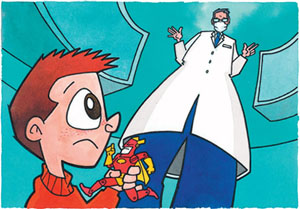
Fig 2-1 A child’s-eye view.
Introduction
Once the level of emotional development and maturity is understood we can begin to predict how a child of any given age might behave. The next key to successful management is to correctly interpret anxiety-related behaviour when it becomes manifest in the surgery.
Anxiety
We know that a toddler manifests only one reaction – crying – to deal with most “negative” situations. It should also be noted that fear of the unknown is widespread in young children. It is normal for younger children to report fear regardless of the anticipated treatment or even prior to their first dental visit (Fig 2-2).
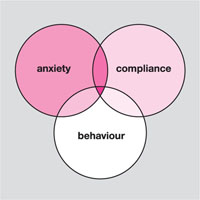
Fig 2-2 Anxiety and behaviour are interlinked in children.
For older children the situation is not so straightforward: they demonstrate anxiety in different ways, and while some signs are easy to spot, others are more subtle. Therefore, we will first explore the reasons for dental anxiety in children and then how anxiety manifests itself, before examining how to deal with it. Anxiety is common and the consequences of anxiety are dependent on the age of the child.
Common dental anxieties in children
The most common dental anxieties amongst children can be attributed to fear of the unknown and the lack of control that dental procedures can impose (Fig 2-3).
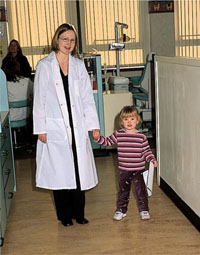
Fig 2-3 Dentist and child.
Fear of the unknown
For some patients, not knowing what is going to happen is a major component in their anxiety. This is demonstrated by the patient who is anxious when you first meet them but who overcomes their worries when they get to know you. They appear happy and relaxed in the surgery until you suggest that they need some treatment. At this point they revert to their anxious state because they do not know what this entails.
One variation on this theme is knowing that something will happen but not knowing when. The classic example is the patient who was once given a local anaesthetic without warning and now expects one every time you move a hand out of their line of sight. For many patients, the unknown is a major source of concern and they require information and explanations in advance to allow them to prepare (Fig 2-4).
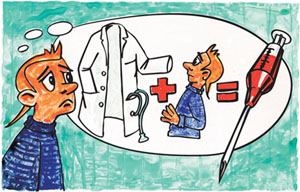
Fig 2-4 Fear of the unexpected.
Lack of control
Lying in a dental chair may produce a feeling of helplessness for many patients. Coupled with an inability to talk to the dentist, because of a mouth full of instruments, this can translate to a feeling like a lack of control. The patient may believe they have no way to interrupt proceedings if something goes wrong.
Factors that influence dental anxiety in children
Dental anxiety is common but clearly not experienced by all children. It is often suggested that a negative dental experience will lead to dental anxiety, but some patients are anxious without ever visiting the dentist while others become happy and compliant patients despite unfortunate introductions to dental care. Clearly, the aetiology of dental anxiety is not straightforward.
Factors associated with dental anxiety include:
-
the attitude of parents towards dental treatment
-
the child’s medical and dental experience
-
the dental experience of friends and siblings
-
the type of preparation at home prior to the dental visit
-
the child’s own perception that something is wrong with his or her teeth.
Parental attitude
The importance of maternal anxiety has been recognised for over 100 years and the relationship between maternal anxiety and child behaviour is well documented. While a definite relationship between the child’s behaviour and their anxiety as assessed by the mother has been shown at all ages, the effect is greatest on children under four years of age. In other words, parents who are anxious of dental treatment tend to have children who are anxious too.
Medical and dental experience
Children who are uncooperative or anxious during a dental visit are more likely to have experienced traumatic or painful dental procedures in the past than those who behave well. However, not all patients who have had pain during dental treatment become anxious. Bernstein and colleagues present data that suggest that the dentist is a key variable in the development of dental anxiety. They took groups of university students with either high fear or low fear towards dentistry and examined essays written on childhood experiences of dental procedures. In the high-fear group 42% had experienced pain during a visit but many of them also reported their dentists to be cold and uncaring, or used similar negative descriptions. Only 17% of the low-anxiety group had experienced pain but for this group the dentist was more likely to be described as careful, caring or friendly. This suggests that an empathic approach may overcome the long-term effects of pain.
Previous unpleasant medical experiences may also affect a child’s subsequent ability to accept dentistry. However, it is the emotional quality of the episode not the number of visits that is significant. Children who have had positive medical experiences may be less apprehensive in the dental surgery. Pain experienced during medical appointments, or at least the parents’ beliefs about the pain experienced, has been found to correlate well with their child’s behaviour in a dental setting.
The dental experiences of others (“vicarious learning”)
Many people who are anxious concerning dental treatment have never had a bad dental experience themselves; for example, many children and adults who have never received a local injection expect it to hurt. Children in particular may learn from exaggerated playground stories but may also reflect the dental anxiety of their parents.
A child’s awareness of dental problems
Children who attend a dentist for the first time and who know they have a dental problem (whatever it may be) tend to behave poorly. It has been suggested that transmission of maternal anxiety may be partially responsible. However, fear of pain is a common finding in children and may also be a significant factor (Fig 2-5).
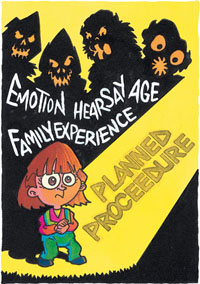
Fig 2-5 In the mind of the child.
A cursory look at these factors shows that children and their families may well be anxious before you ever meet them. Their introduction to your surgery can make it better or much worse. For example, the way the appointment is made will influence the parents, the parents anxieties will influence the child. The appearance of the staff and the reception area, the sounds, the smells that greet the patient all send messages, and the family are forming a view of your practice before they see you for the first time.
How children manifest anxiety
Toddlers
Toddlers are generally “pre-co/>
Stay updated, free dental videos. Join our Telegram channel

VIDEdental - Online dental courses


